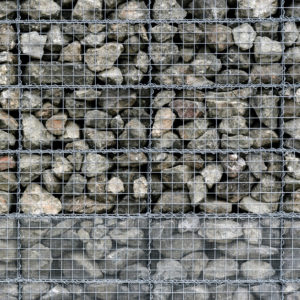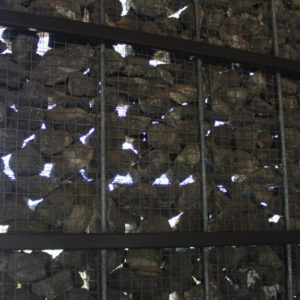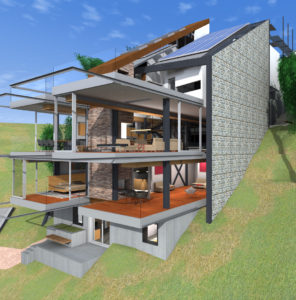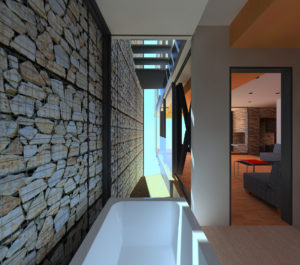Content precedes design. Design in the absence of content is not design, it’s decoration.
~ Jeffrey Zeldmaan
Design Process
The Owners and mills studio jointly determined that the best way to achieve an integrated and unified vision for the DTS Project House was to make a single entity, mills studio, responsible for the architecture, interiors, and landscape, and also for the construction execution.
The DTS Project House design is the result of an intense dialogue between mills studio’s architectural agenda and the Owner’s specific intentions and requirements. The design process was the continual evaluation of how specific responses to the particular parameters of site, codes, and the Owners requirements aligned and fulfilled mills studio’s architectural agenda.
The DTS Project House design process began with the thorough documentation of the physical and environmental properties of the site and neighborhood, and the broader context that mills studio believed the DTS Project House must account for. An extensive source library of relevant images and existing projects to visit was developed for both inspiration and to create a broader context for the project’s development. Continuous research was conducted and experts in various disciplines consulted to find new potentialities in integration and materials and find the frontiers of technology innovations. All potential design decisions were documented, evaluated and tested in drawings, models, renderings, and extensive 3-D computer modeling.
Context
mills studio documented the broad context that it believed should inform and inspire the DTS Project House design. The context precedes and exists separate and apart from the DTS Project House design. Context is a combination of both what we are forced and what we decide to account for in a design. mills studio brings certain aspects of context to all of its projects; some aspects of context are specific to the DTS Project House’s location; and other aspects of context are specific to the Owner’s intentions for the DTS Project House. The broader the context that a design can significantly account for, the more the architecture can simultaneously connect to the past, present, and future. Like all buildings, whether architecture or not, the DTS Project House will become a part of and help define the context for future projects.
Site
Before any design work was commenced, the physical, environmental, and psychological characteristics of the site were first experienced and then documented in detail. Data, photography, drawings, and models were combined to provide a complete understanding of the site and the parameters that the design must accounted for. It was important to experience and understand that the site’s canyon location gives the site a presence from various vantage points both close and far, both above and below, and both from and toward. Responding to the existing site is not discretionary, and ignoring any existing site condition is a telling response in itself.
Inspiration
Existing architectural and landscape projects, movements, and individuals serve as inspiration for specific aspects of the DTS Project House and most importantly fuel the desire for significant achievement. Different points in the design process called for different forms of inspiration, from images, to field trips, to videos, to lectures, to museum and gallery exhibitions, to product launches, to trade shows. The idea of a “Project House” itself was inspired by local precedents like Richard Neutra’s VDL House and the Case Study Program. mills studio and the Owners attempted to find inspiration in a diverse collection of both the universal and particular.
Research
Continuous, unending research was and is an integral part of the design process for the DTS Project House. Research was conducted to inform known specific aspects of the project, such as concrete, and research was conducted for exposure to the otherwise unknown. Often research intended to inform one aspect of the design triggered notions in unanticipated areas of the project’s development. Research took many forms from internet searches to field trips to product launches to trade shows to consultant’s input. Research is most valuable if the results can be implemented and the continuous research throughout the design and construction process requires a design that is sufficiently flexible to welcome and adjust the introduction of additional knowledge and new parameters.
Schematic Design Phase
The Schematic Design Phase defined the specific parameters that determined the project’s development and proposed responses to these parameters. The site’s well defined parameters combined with building and zoning codes did not allow for varied options for general site organization. Fortunately, many of the required responses to specific parameters aligned with mills studio’s architectural agenda. Thus, Schematic Design was less about looking at organizational options than about defining the character of that organization. Entry, circulation, and structural approaches that reinforced the architectural intent were defined. The distinctive elements of retaining, glass boxes, water element, and protective wrapping were all defined and organized into an intentional spatial experience.
Design Development Phase
The Design Development Phase refined the approaches determined in the Schematic Design by adding the input of consultants and implementing the decisions necessary to make the design constructible. Specific materials, elements, and treatments were proposed and evaluated for which best expressed the architectural agenda and desired character of the aesthetic experience. The competing interests of all the disparate parameters that make for a dynamic architecture were hopefully organized into an integrated physical, intellectual, and spiritual experience that was ready to document in construction documents.
Construction Documents Phase
The Construction Documents Phase is equally important as the design phases because unless the design can be faithfully executed it is of little value. Since mills studio is both designer and builder the construction documents are more an internal working out of detailing and assuring proper coordination and integration than explaining the construction to a third party. The architecture of the DTS Project House is about incorporating the best of modern systems in a house of concrete with few solid walls so proper advanced planning for infrastructure was a critical part of the Construction Documents Phase. The DTS Project House aesthetic of exposed structure required consideration of every structural connection and joint between materials with large scale construction drawings so the true scale impact would be intentional.
Evolution
If a project is to truly be a Project House and both take advantage of and showcase the most current design thinking and products, the design cannot ever be considered truly finished. Although certain structural aspects have to become fixed, if they define a sufficiently clear and powerful vision they will allow adjustments and responses to changing conditions and additional inputs. Therefore, of equal importance are intentions that remain constant and a design that continues to improve and adjust to a changing and evolving world.
Whatever our task, whether large or small, in every case, opposites must be reconciled. Almost every formal assignment involves dozens, often hundreds, sometimes thousands of conflicting elements that can be forced into functional harmony only by an act of will. This harmony cannot be achieved by any other means that art. The final value of individual technical and mechanical elements can only be assessed afterwards. A harmonious result cannot be achieved with mathematics, statistics, or probability calculus.
~ Alvar Aalto
Design Criteria
Establishing a criteria for evaluating design options and decisions is critical to achieving significant architecture. A clear vision of values establishes the criteria for judgement prior to creation as the criteria for judgement must not become a malleable justification for design decisions made simply for expediency or because we like them. Otherwise the work risks becoming a building we like, but not significant architecture. Everything we like is not necessarily good nor good for us, and certainly not good for an enduring community. Design responses are of little value if we do not have an appropriate criteria for judging them.
All DTS Project House design options and decisions were evaluated for their general contribution to mills studio’s architectural agenda, the Owner’s specific design and lifestyle intentions, and then their specific contribution to excellence and innovation in Design, Technology, and Sustainability. The favored design options simultaneously address multiple intentions, advance multiple disciplines, and positively contribute to the aesthetic experience.
The rock filled gabion walls serve as a case study of how a single DTS Project House design decision and element addresses multiple concerns:
- contributes to mills studio’s agenda of expressing the family unit as the institution that acts as the all important filter between the individual and the larger world.
- contributes to the Owner’s requirement for a project with an Iconic presence, a house open to views with privacy, and a recycling of elements existing on the site.
- recycled rock filled cages reference the immediate physical geological context, the context of the neighborhood’s historic granite walls, and the Los Angles architectural context of Frank Lloyd Wright’s perforated textile blocks.
- are a dynamic Design element providing ever changing texture and filtered light.
- provide the desired contrast between the natural organic and the manmade precision of glass and steel boxes.
- creates the context of earthbound weight for the weightless floating glass boxes.
- establishes physical and metaphorical limits for the glass boxes to violate accentuating physical and individual liberation.
- makes landscape / hardscape an integral experience of everyday life on every level in the building.
- provides omnipresent large scale interior design element grounding individual small scale furniture pieces.
- attempts to improve on and make an ancient Technology modern.
- contributes to Sustainability by recycling the site’s concrete and excavated rock, is non maintenance, acts as shade protection, and acts as a thermal mass.
Architecture is like writing. You have to edit it over and over so it looks effortless.
~ Zaha Hadid




